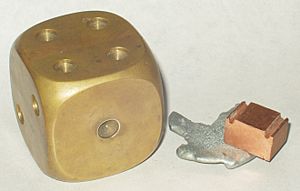Brass facts for kids
Brass is a special kind of metal mix, called an alloy. It's mostly made from two other metals: copper and zinc. Sometimes, certain types of brass are even called bronzes because they look and act a bit similar.
Brass usually has a shiny, golden color. It's stronger than pure copper or zinc. It also doesn't rust or get damaged easily by air and water, which is called corrosion. While it costs more than just zinc, it's very useful!
There are a few main types of brass, depending on how much zinc is mixed in:
- Alpha brass has less than 40% zinc.
- Beta brass has a bit more zinc.
- White brass has a lot of zinc, more than 45%.
You can find brass in many everyday items. Here are some things it's used for:
- Brass instruments like trumpets and trombones
- Shiny ornaments and decorations
- Parts for electrical systems
- Buttons on clothes
- Screws and hinges
- Taps for water
- Door knobs
Contents
What Makes Brass Special?
Brass has some cool features that make it very useful. It's more malleable than bronze or zinc. This means you can easily shape it or flatten it into thin sheets without it breaking.
How Hot Does Brass Get?
The melting point of brass can be different. It depends on how much copper and zinc are in it. Brass usually melts between 900 to 940 degrees Celsius (1,650 to 1,720 degrees Fahrenheit).
How Heavy is Brass?
The density of brass is about 8.4 to 8.73 grams per cubic centimeter. This tells you how much a certain amount of brass weighs.
Is Brass Recycled?
Yes, brass is very good for the environment! Almost 90% of all brass alloys used today are recycled. Old brass scrap is collected and sent to a special factory called a foundry. There, it's melted down and reshaped into new pieces called billets. These billets are then heated and stretched to make new brass items.
Does Brass Stick to Magnets?
No, brass is not ferromagnetic. This means it won't stick to a magnet, unlike iron or steel.
Can Brass Get Damaged?
Even though brass resists corrosion, it can still get damaged. This happens if it's around moisture, certain chemicals like chlorides or ammonia, or some strong acids.
Different Kinds of Brass
There are many types of brass, each with slightly different amounts of copper and zinc, and sometimes other metals too. These different mixes give them unique properties for different uses.
Some examples include:
- Admiralty brass: Often used in ships because it resists saltwater.
- Cartridge brass: Strong and good for making bullet casings.
- Gilding metal: Looks very much like gold and is used for decorations.
- Naval brass: Another type used in marine environments.
- Red brass: Has more copper, giving it a reddish tint.
- Yellow brass: Has more zinc, giving it a yellower color.
Images for kids
-
Brass astrolabe
-
Brass lectern with an eagle. Attributed to Aert van Tricht, Limburg (Netherlands), c. 1500
-
Cracking in brass caused by ammonia attack
-
Brass aquamanile from Lower Saxony, Germany, c. 1250
See also
 In Spanish: Latón para niños
In Spanish: Latón para niños












